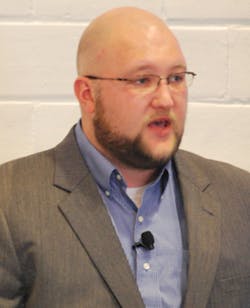Sometimes even the latest and greatest analytical software and devices can use some traditional values to get up and running and function with the greatest efficiency. This was one of the primary lessons of a three-person panel that presented "World-Class Monitoring + Diagnostics" today at the Minds + Machines 2015 conference in San Francisco.
Clint Carter, director of operations and services at Luminant Power, reported that its Power Optimization Center (POC) helps many plants monitor and manage their coal, natural gas and nuclear power plants. This process begins with gathering data from advanced sensors and wireless equipment monitoring systems, which are then connected to POC via digital networks. This input lets Luminant conduct advanced pattern recognition, develop deeper insights into the performance at its clients' facilities, and identify power-generation challenges, performance degradations, and/or faulty controls and instrumentation. The center was started in 2005, now runs 24/7, and often recognizes issues that are going to emerge before its clients see them. More recently, POC has established a cybersecurity desk, and may soon offer security services.
From diagnostics to prognostics
"We find issues that need to be dealt with immediately, but we usually identify longer-term situations," said Carter. "We typically capture vibration data a couple of times per day, which tells us if an asset's condition is changing. We started using what is now GE Proficy SmartSignal in 2005, and right away it found a primary air fan with an oil leak that would have caused its unit to be lost if it hadn't been found."
"Early detection of equipment issues means a lot of savings." DTE Energy's John Ewald on the $1 million saved to date through reduced downtime.
Carter added that the M+D field is transforming from alarms to diagnostics to prognostics, and it's also being driven by the Internet of Things (IoT) and the collaboration it allows.
Similarly, John Ewald, principal engineer at DTE Energy, reported that its Detroit-area, fossil-based plants have been using GE Proficy SmartSignal for about 10 years for M+D, advanced calculations, real-time monitoring and predictive maintenance. DTE even established an internal M+D center as the "front door" to fleet.
"We still have some manual input of abnormal conditions, but we can do virtual-environment plant tours, too," said Ewald. "We're also conducting knowledge capture from our veteran operators, adding it to SmartSignal, and integrating it with our subject matter experts."
$1 million and counting
Besides running its own M+D center, DTE also works with GE's Industrial Performance Reliability Center (IPRC), which is helping the utility update its models, develop new training, and integrate new wind-based generating systems. "Early detection of equipment issues means a lot of savings," said Ewald. "So far, we've saved about $1 million by reducing downtime and unplanned outages. For instance, the IPRC recently noticed that a wind nacelle was having temperature control problems, and found a bad contactor on a cooling fan. In another case, a gearbox was having temperature deviations, and we learned that its thermostat needed to be replaced. All of this data is easily accessible at our M+D center."
Chad Stoecker, IPRC manager, added that it provides software as a service (SaaS), and performs data processing for 200,000 sensors on 6,000 assets at 250 generating units. Each week, its 35 reliability engineers produce more than 60 reports, conduct more than 50 calls with clients, and publish more than 40 actionable notifications. Together, its analytical capabilities and personnel help customers make the transition from reactive to predictive M+D.
"If there's a possible trip, we need to respond immediately with high-speed data to avoid an incident, but we're also doing more predictive analytics that tell customers when issues start to emerge, so they have time to plan," said Stoecker. "We typically do weekly calls to collaborate and plan. Our main job is to determine what threats to production exist and decide how to minimize them."
'Dollars to Catches'
Stoecker added that IPRC has started a "Dollars to Catches" program, so users can demonstrate the actual return on investment of M+D, predictive analytics and optimized performance. "It's also crucial for us to show customers that we have people who've been in their shoes" added Stoecker. "A lot of what we do is detecting and fixing malfunctioning sensors, but IPRC's main theme is still plant buy-in and trust. M+D centers are there to make on-site engineers shine and excel in their jobs. In addition, we've got deep experience with SmartSignal, but now we're also starting to migrate everyone to the full Predix platform, which will let us do even better M+D and maintenance."
Carter added, "Initially, POC was viewed as big brother, but we eventually brought in all our customers' operators and shift supervisors for a day to show them what we do, and the most common response was, 'This wasn't what we expected. You really are trying to help us.' Developing personal relationships with the control rooms guys is crucial to our success."








